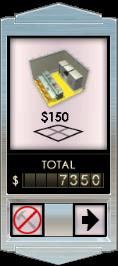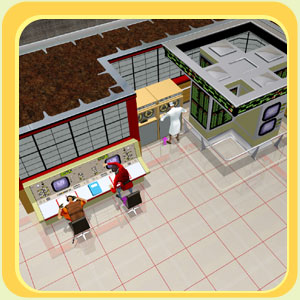When constructing your base, the entire base will be made out of different types of rooms. Having different rooms allows you to organize your base neatly, as well as help in navigation (based on the fact that all rooms have different floor tiles, and therefore are distinguishable).
All rooms have specific purposes. The most basic is the corridor, linking all the rooms together, which can be armed with traps and doors to help keep agents at bay. Other rooms function to help keep your minions in top form, research new items, train new minions, store your wealth and help run your base.
Contents |
Overview
Building Rooms
Rooms are built by mining the earth in the mountain. Your minions will do this for you, following the orders you give them in the guise of a blueprint.
To begin building a room, move your cursor over a free piece of unmined dirt. The cursor should change into ![]() when over an acceptable area. Right click where you want to start building and the list of rooms you have available to build appears on the left side of the screen. The cost for one tile of the room is also shown. Left click on the type of room you want to create.
when over an acceptable area. Right click where you want to start building and the list of rooms you have available to build appears on the left side of the screen. The cost for one tile of the room is also shown. Left click on the type of room you want to create.
 |
A new window will appear in the upper-left corner of the screen, detailing the specifics of the room you chose. There are two options in this window – the left cancels the blueprint and the right commissions the room.
You can now drag out your blueprint to the area you wish to create into the room. This is done by left clicking and dragging an area, or by selecting the tiles one by one. Make sure that the room is connected to a corridor.
There are some simple rules about how to design a blueprint. First off, you cannot dig in solid rock. You can also not split up the blueprint in 2 separate pieces. If you would like to add another room of the same type, you first need to finish the first room and then you can proceed by creating a blueprint for the second room, following the same procedure. You can also not make a 1-tile wide corridor, at least not in a straight line. A tile must have at least 2 tiles beside it which are not opposite of each other, which means it IS possible to create a 1 tile-wide corridor in the shape of a stair.
 An example of a blueprint An example of a blueprint |
 Blueprint errors Blueprint errors |
 Items placed before the room is built Items placed before the room is built |
A new window will now open, with more options. The first, reading from left to right, is the “return to blueprint” mode, which allows you to further edit your room layout. The second cancels your room and blueprint. If you click this, you’ll have to restart the process from scratch. The third button, a hammer, starts construction. The fourth, a crate, allows you to purchase and place items in your blueprint. The final one, the trap button, allows you to purchase and place traps in your blueprint.
When the room has started construction, there will be a visible tag on it, which allows you to pause or resume building. The minions will run to collect dynamite, blast open the room, and decorate it under a tarp. When the tarp disappears, the room has been completed.
 Minions go purchasing dynamite Minions go purchasing dynamite |
 The dynamite is placed The dynamite is placed |
 Ready? Ready? |
 KABOOOOOMMM!!! KABOOOOOMMM!!! |
Tips for Room Construction
- To save space (and money), don’t make rooms larger than needed. A large empty space in the center of a room is generally a sign of poor layout, and should be avoided whenever possible. Generally a good idea would be to build another room in the center instead: a well known example is a small Inner Sanctum in the middle of the Control Room.
- Build your base in terms of “heat zones” – essentially putting your zero-heat rooms near entrances to waste the time of investigators, and high-heat rooms deep inside your base to buy you time to get intruders out.
- Put high-value items and assets deep in your base. Power generators, key targets for saboteurs, can still work hidden deep in the back of your base where enemy agents will have a long walk to get to them. Do the same for stolen loot, your strong room, research equipment, control rooms, weapon racks, freezer racks, and even a large barracks for lockers (minions don’t actually use the lockers, but they serve a purpose).
- Try to combine stolen loot with high traffic areas or items that have long useage cycles. This way your minions pick up some perks on their stats when they walk by.
- You don’t need solid walls on every side of a room. You can cluster rooms together to open the flow of traffic at the expense of some security or use of wall-mounted items.
- Build corridors between clusters of rooms. A single, long corridor is helpful at times, but if you’re planning on moving rooms around or expanding you may have to cut off entire sections of corridors during your remodel, potentially cutting off supplies or causing your locked-in minions to freak out. It’s easier to create alternate corridors through to clusters rather than around them.
- Feel free to pause the game when planning your base. You can make blueprints of rooms, experiment with item placement, and even consider tradeoffs in power, traffic, and security without actually committing the money, minions, or time to your design just yet.
- Clustering rooms is good because they act as one-stop-shops for stat recovery for your minions. Training, research, combat, even outsmarting your enemies can chew into health, smarts, endurence, and attention. Should anyone pass out, you can guarantee that your social minions will carry off the victim to a predictable area. And once that key stat is recovered, the minion can then work on other low stats.
- Don’t get frustrated with “disappointing” or “failed” base designs. All the best evil geniuses out there learned their tips and tricks to room design with lots of trial and error. Besides, the process is fun to watch while you learn. With enough time and patience, your evil genius will amass enough money, power, and minions to build your dream base. All that limits you is your creativity!
List of rooms
Base Rooms
 Archives Archives |
 Armoury Armoury |
 Barracks Barracks |
 Control Room Control Room |
 Corridor Corridor |
 Freezer Freezer |
 Hangar Hangar |
 Infirmary Infirmary |
 Inner Sanctum Inner Sanctum |
 Laboratory Laboratory |
 Mess Hall Mess Hall |
 Power Plant Power Plant |
 Staff Room Staff Room |
 Strongroom Strongroom |
 Training Room Training Room |
Other Rooms and buildings
 Dock Dock |
 Helipad Helipad |
 Hotel Lobby Hotel Lobby |
 Hotel Casino Hotel Casino |
 Hotel Lounge Hotel Lounge |
 Topside Shack Topside Shack |
Reference “https://evilgeniuswiki.wordpress.com/wiki/rooms” Category: Rooms


